Jazz for the struggle and the struggle for jazz
The Rainbow is one of many art spaces struggling to survive the Covid-19 lockdown. The venue’s place in the history of South African jazz and the struggle against apartheid is extraordinary.
Author:
15 May 2020

“I said, ‘Heita!’” the mlungu [white man] on stage shouts into the microphone. “I said, ‘Heiiitaaa!’”
The crowd responds with an ear-splitting, “HEITA!”
“Phansi amaBhunu! Phansi! [Down with the Boers! Down!],” he continues, working up the crowd.
“PHANSI!” the crowd roars back at the white man.
And so another 1980s gig at the Rainbow in Pinetown, an industrial neighbourhood on the western edge of Durban, gets under way.
The Rainbow Restaurant and Jazz Club, to give the venue its full name, was started by Ben Pretorius and his friend and business partner Billy Mthembu in 1981. Alongside the Radium Beer Hall in Johannesburg and the Galaxy night club in Cape Town, it is one of the longest-running live music venues in South Africa. It might not have the glamour of the Blue Note in New York or Ronnie Scott’s in London, or the Bimhuis in Amsterdam, but it is a globally significant site of music and struggle heritage.

The Rainbow is situated right at the bottom end of Pinetown’s Stanfield Lane, amid the hustle of the nearby taxi and bus ranks with their thrumming street sellers, cellphone repair shops and hairdressing salons. Long before Archbishop Desmond Tutu spoke about “the rainbow nation”, and before that became cliché and passé, “The Rainbow”, as the locals call it, offered a glimpse of the possibilities of a freer society that could sing and dance and love across the colour lines despite the uncertainty of those times.
Now, the beloved venue that has always had a largely working-class support base, and has always been committed to a progressive political vision, faces a different kind of uncertainty. The Covid-19 lockdown has made it impossible for entertainment and arts venues to continue operating in their usual capacity, and many may not survive the crisis. The Rainbow has begun a crowdfunding campaign to keep the venue, and its storied history, alive.
Memorable moments in song and struggle
The venue’s first gig was by Philip Tabane and Malombo in May 1983. Since then, there have been several memorable moments with crowd favourites like the African Jazz Pioneers, Winston Mankunku Ngozi, Robbie Jansen, Sipho Gumede, Busi Mhlongo, Madala Kunene and many more performing over the years. And while some of these artists can’t really be called jazz musicians from a purist’s point of view, they all remain “our own” just like the music of Ladysmith Black Mambazo and its offspring, Shabalala Rhythm – perennial favourites at the venue.
At the end of the 1970s, Pretorius had finished his degree, then backpacked around Europe for a while before living in London. There he hung out with South African exiles who taught him about jazz, became aware of the protest music of Peter Tosh and Bob Marley, and recognised the political power of music.

On his return to South Africa in 1981, he hooked up with his old friend Billy Mthembu and looked at the possibilities of a joint business venture, each putting in R7 000 to get the venue off the ground. When dealing with the authorities back then, it was not easy getting the permits that allowed different races to mix and mingle over a meal, or to get a liquor licence. But they eventually got over these hurdles and established their club near the taxi rank in Pinetown.
One of the first political marches I saw was in an old Pace magazine in December 1985. In photographs by Omar Badsha, a group of musicians with trumpets, saxophones and guitars marched behind a banner that read, “Jazz for the Struggle, the Struggle for Jazz”. That same banner now hangs above the entrance to The Rainbow.
December 1985 has been the date for a traditional birthday gig ever since. It used to be called the Dingaan’s Day gig and then Not the Day of the Vow gig in opposition to the Nationalist Party’s Day of the Covenant commemorating the battle of Blood River. Now it is simply called The Rainbow’s Birthday Bash.
Following the rainbow
I’d been seeing photographs and reviews of concerts at The Rainbow in the local papers, and so one Sunday in 1986, fellow photographer and Afrapix member Cedric Nunn and I decided to investigate. Off we went on Ceds’ 350cc Honda motorbike with his camera bag on the left and mine on the right for balance, and quickly got lost, nearly ending up in Clermont township.

Stopping to fill up with petrol, we were redirected to the Crompton Street area in Pinetown and eventually found the place. We tried the usual media trick of getting in for free, saying we wanted to document the gig, but Pretorius was having none of that, saying we should have made prior arrangements. So we paid the entrance fee and entered the magical space that Pops Mohamed calls a “sacred space” in the South African music scene. At the next gig, we pitched up with some prints for Pretorius who said, “Well, that’s the first time the media have given me anything.”
He and Mthembu were proud of the fact that they had never taken out an advert for any gig in any publication – it was purely word of mouth and the reputation for a good time that filled the place regularly. As media, it was a time when we were running around the townships documenting events that weren’t being covered by the mainstream media of the day. And so The Rainbow became a haven for us, allowing us to unwind after witnessing and photographing a funeral or rally or a meeting or acts of state violence during those traumatic times.

Cultural politics
The Rainbow is a loud, rowdy and often raucous place with the audience and the band feeding off each other’s energy. It is definitely not a “sit down and listen carefully” concert venue. The audience roars if a solo wins its approval. It was always a brave artist that attempted to play a ballad there, unless you were Sipho Gumede starting the first notes of Mantombi as the shouts of recognition drowned out the first few bars of the song.
The gigs are held on Sundays. As the afternoon goes on, people get up and dance, forming a train that snakes between the seating booths, down the aisles and past the stage, waving and applauding the musicians as they pass by. iStimelen’ sase Rainbow – the Rainbow train – it’s called, which allows total immersion in the moment. As one punter memorably put it: “Fuck tomorrow, fuck the bosses, fuck the system, we’ll worry about that later. Now we’re just gonna let go and get down and forget about all that shit.”
-
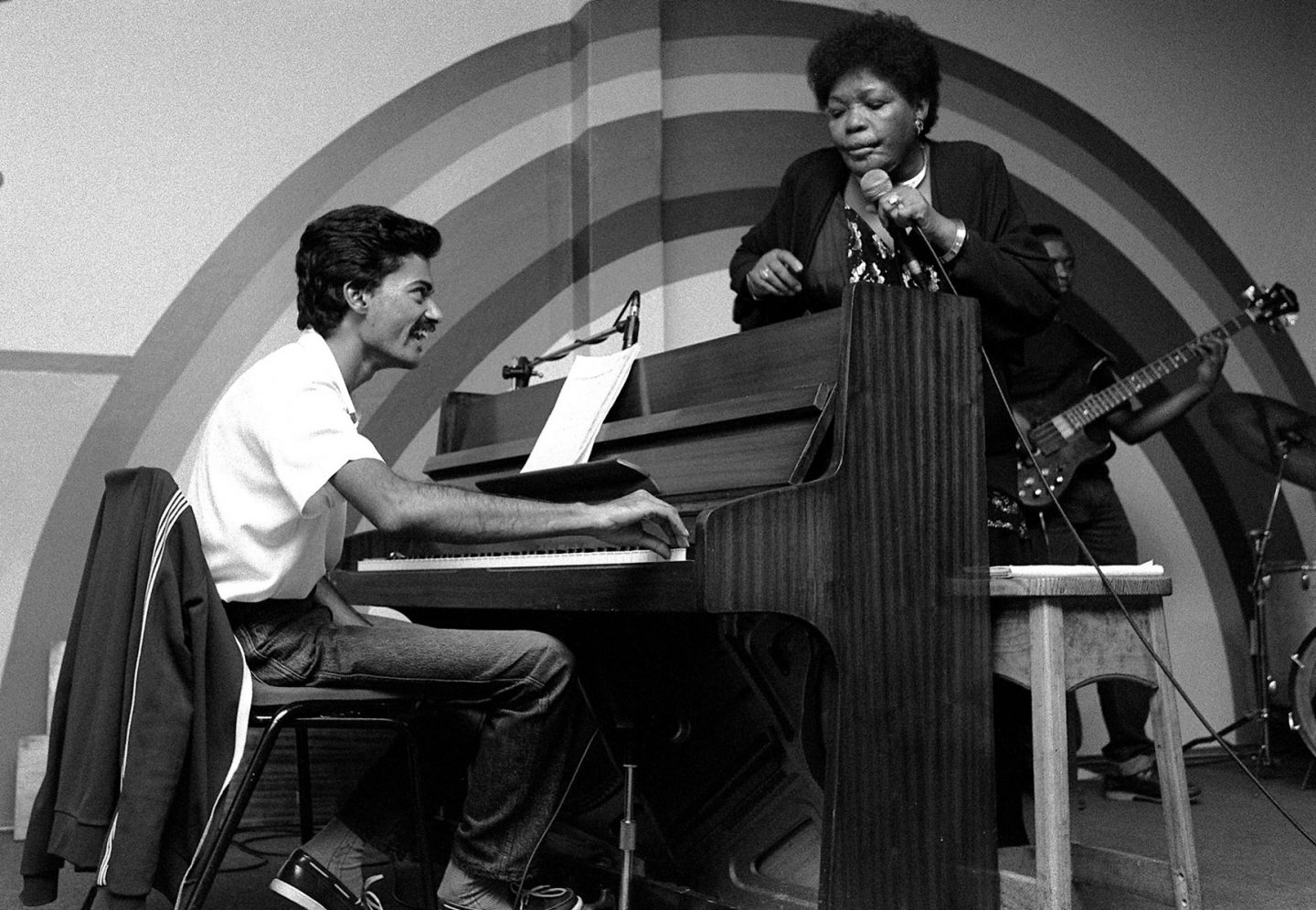
1992: Jazz legends Melvyn Peters and Thandi Klaasen. -
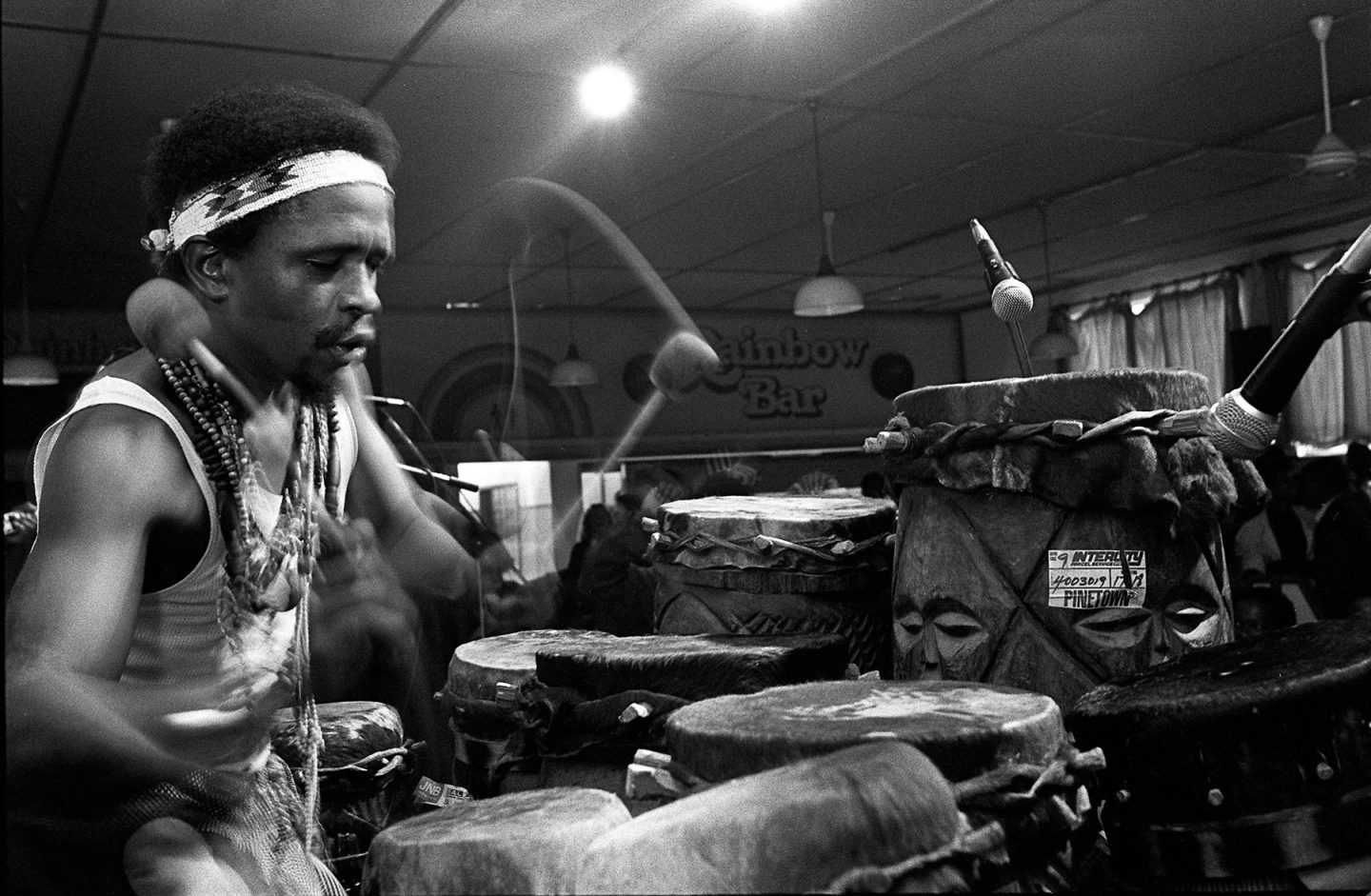
May 1990: Oupa Monareng from Malombo.
-
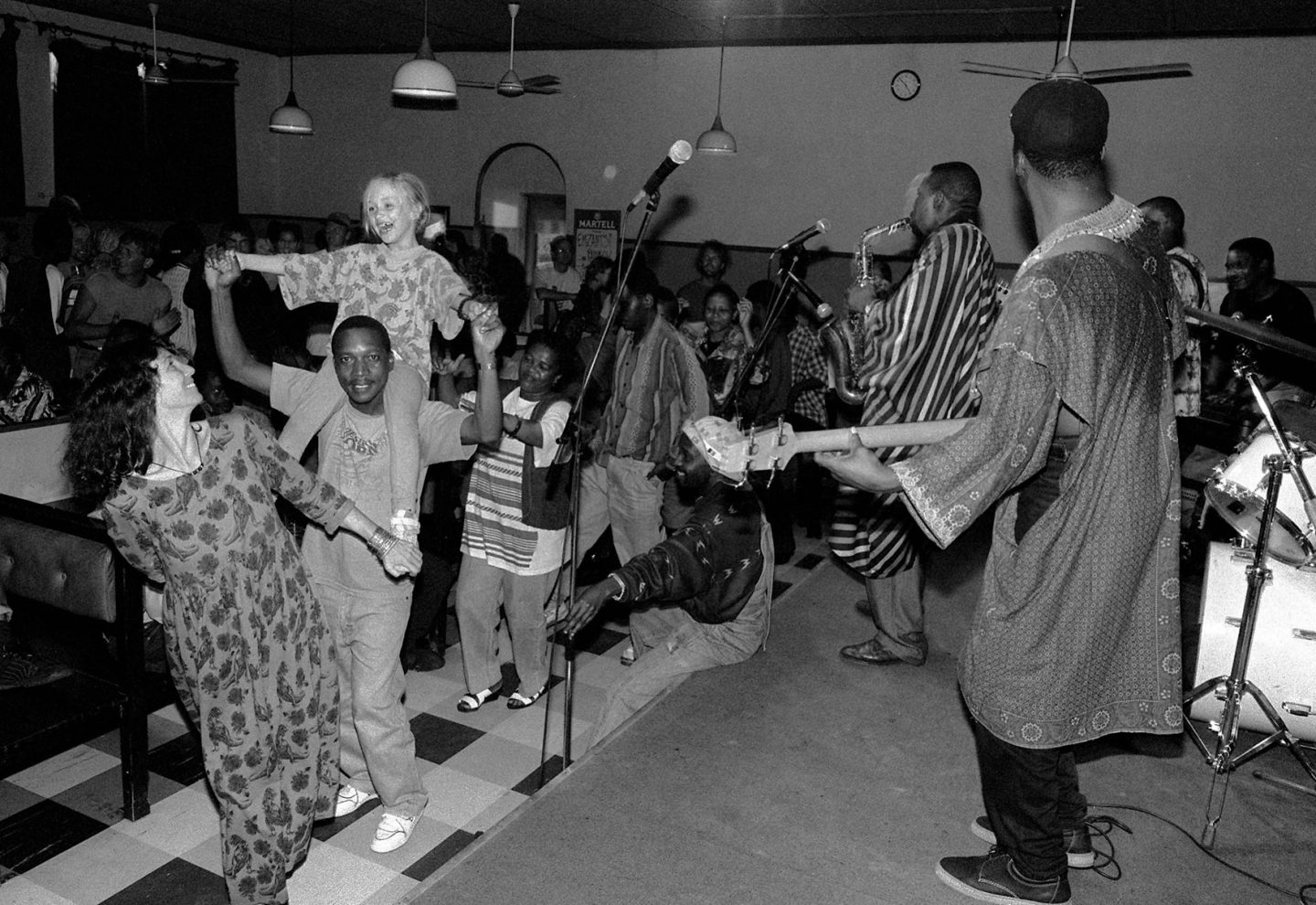
November 1996: Crowds dance to the music of Mzantsi. -
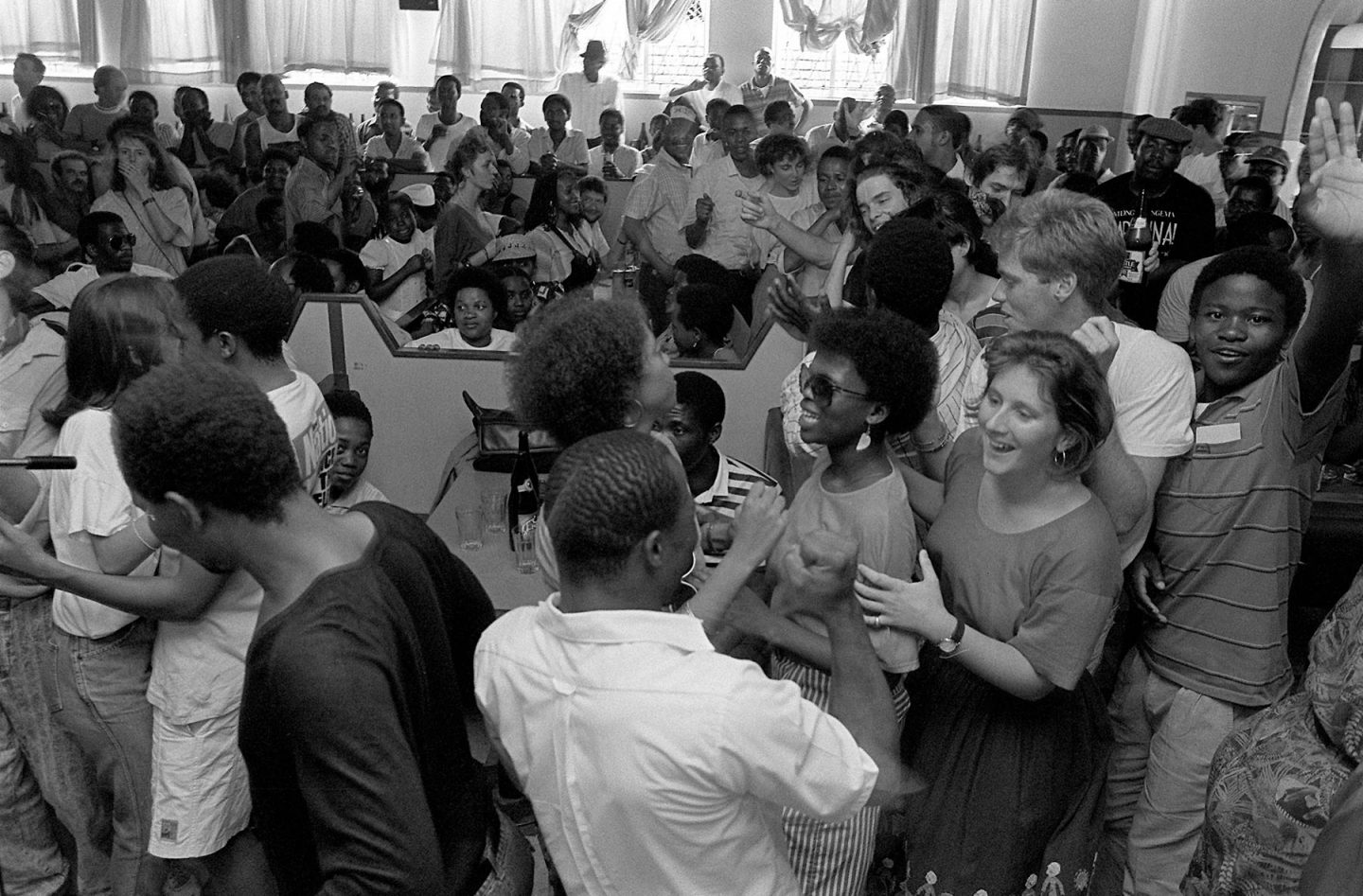
December 1989: African Jazz Pioneers make everyone jive.
-
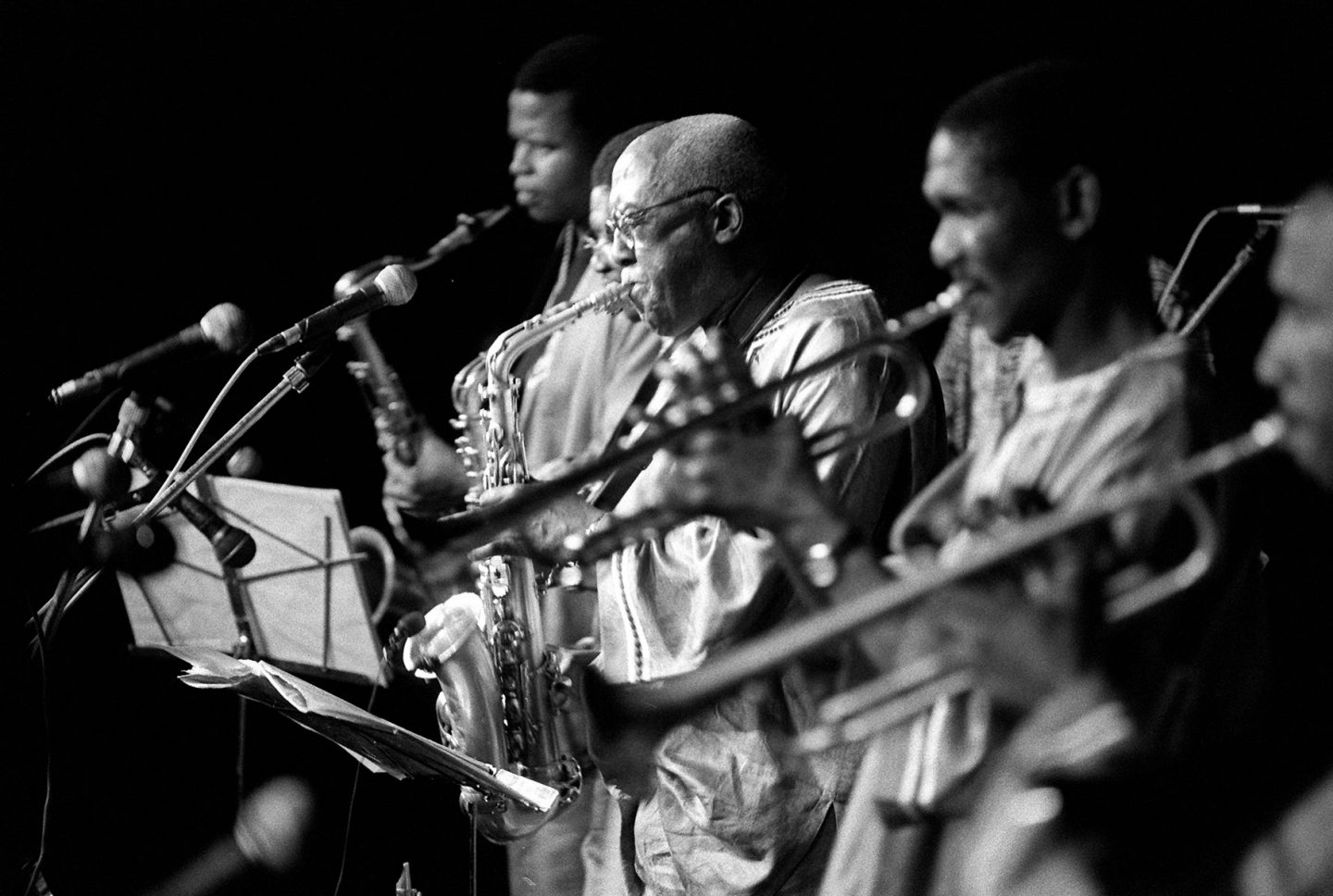
March 1996: Ntemi Piliso, leader of the African Jazz Pioneers, on saxophone. -
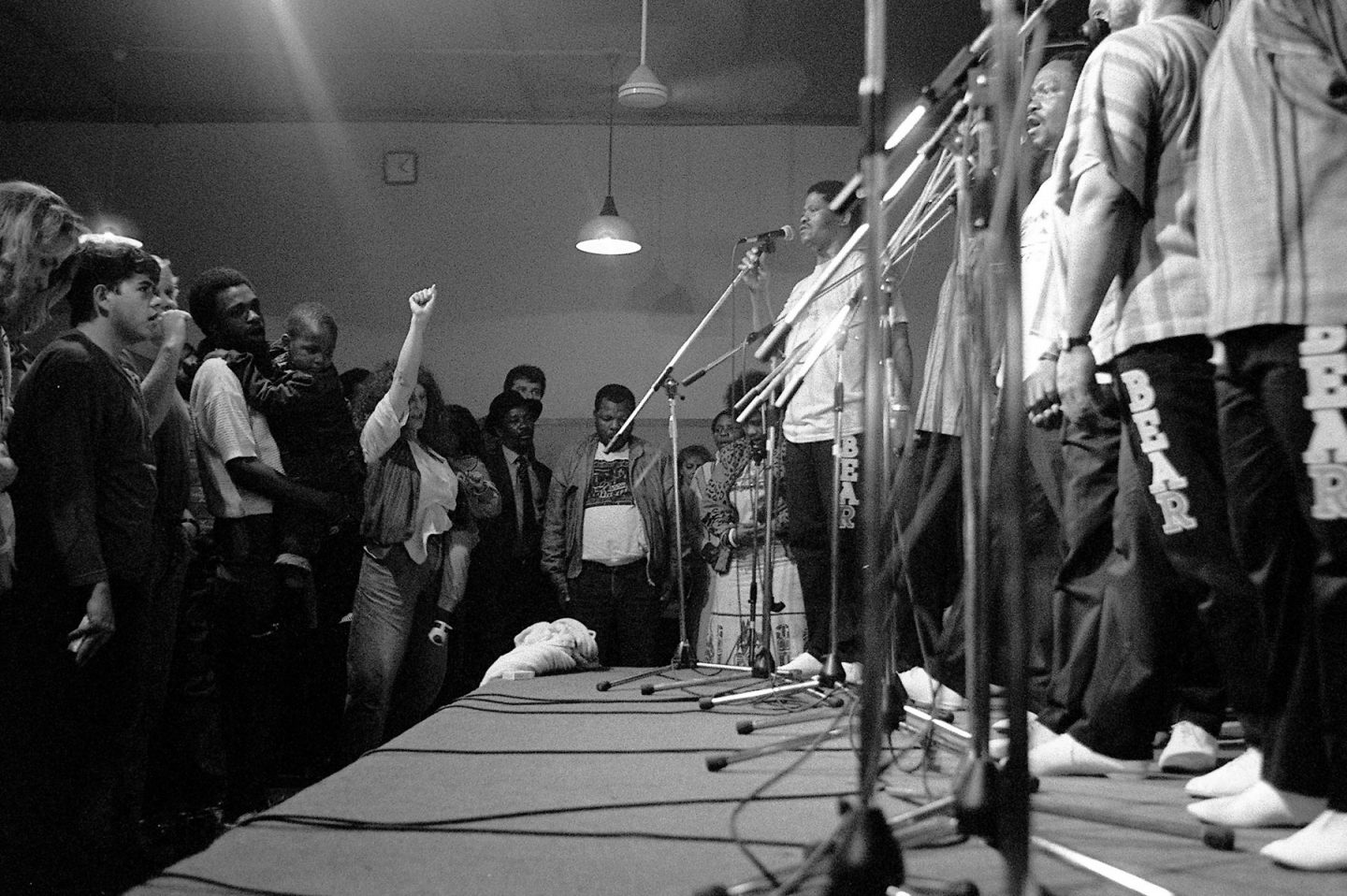
August 1989: Singing Nkosi Sikelele Afrika at the end of the performance by Ladysmith Black Mambazo.
The Rainbow was intimately linked with the politics of the 1980s, when South Africa was under states of emergency. Sometimes Pretorius would cheekily offer any Special Branch members in the audience free batteries for their recording devices. In 1988, when Nelson Mandela’s 70th birthday party concert at what was then the University of Durban-Westville was banned, it moved to The Rainbow. Despite efforts by the authorities to stop it – cops harangued Pretorius over his liquor licence, which was valid, while armed police and Security Branch members packed into the venue – the show went on.
From the stage, Pretorius pointed out to them, “This is a trumpet, not a rocket launcher, and this is a guitar, not a gun.” After a while, they left and the music stopped. Nkosi Sikelel’ iAfrika, the original version by Enoch Sontonga, was sung and then the music continued. When workers at SA Breweries went on strike in 1988, Pretorius stopped sales of their products in solidarity, even though it meant a huge loss for the club. The National Union of Metalworkers of South Africa had offices up the road and many of the union’s members frequented the place. Next door was a hall that the South African Council for Higher Education used for meetings and events like May Day commemorations where The Rainbow’s sound system was used mahala (for free).
During the fighting that took place in the 1980s between the UDF and Inkatha, and the ANC and Inkatha’s later iteration, the Inkatha Freedom Party, in the early 1990s, many refugees from the violence in Hammarsdale and Mpumalanga were housed and fed at the Rainbow until alternative arrangements could be made. In the heady days after Mandela’s release, the ANC’s Highway Branch was launched there.
Mthembu, who had other businesses in the townships, sold his shares to Pretorius. After a surprise 50th birthday party for him in June 2001, Pretorius sold the business to Neil and Nicola Comfort.


A new era with the same ethos
The Comforts maintained the ethos of The Rainbow and have hosted several memorable gigs including Vieux Farka Touré, Nathalie Natiembe, Jaojoby, Lindigo from La Reunion and many more from elsewhere on the continent. This was through Neil’s ongoing relationship with the Alliance Française and the Zakifo Festival, which has had positive spin-offs for the venue.
Acts like The Muffins, the Brother Moves On, Shabaka Hutchings, Mandla Mlangeni, Bokani Dyer, Ildo Nandja, Linda Sikhakhane, Tumi Mogorosi, S’bu Mashiloane, Lelo Mazibuko and other younger musicians from the current crop have graced the stage. There have also been appearances from the likes of Feya Faku, Lex Futshane and stalwarts including Melvyn Peters, the Umkhumbane Jazz Ensemble and even the great Louis Moholo-Moholo. This has introduced new and younger visitors to the joys of the venue.
-
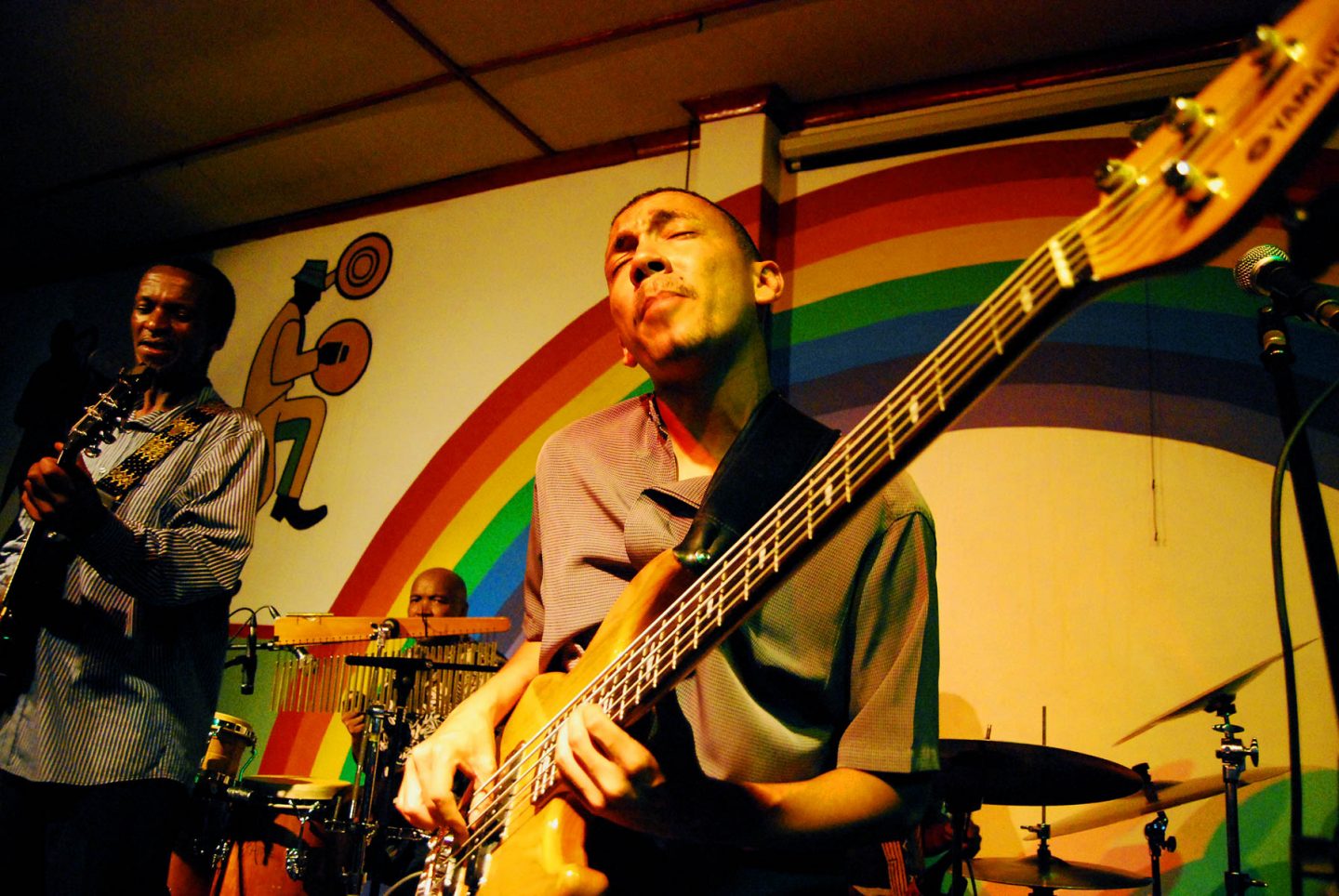
November 2015: Bassist Michael Phillips. -
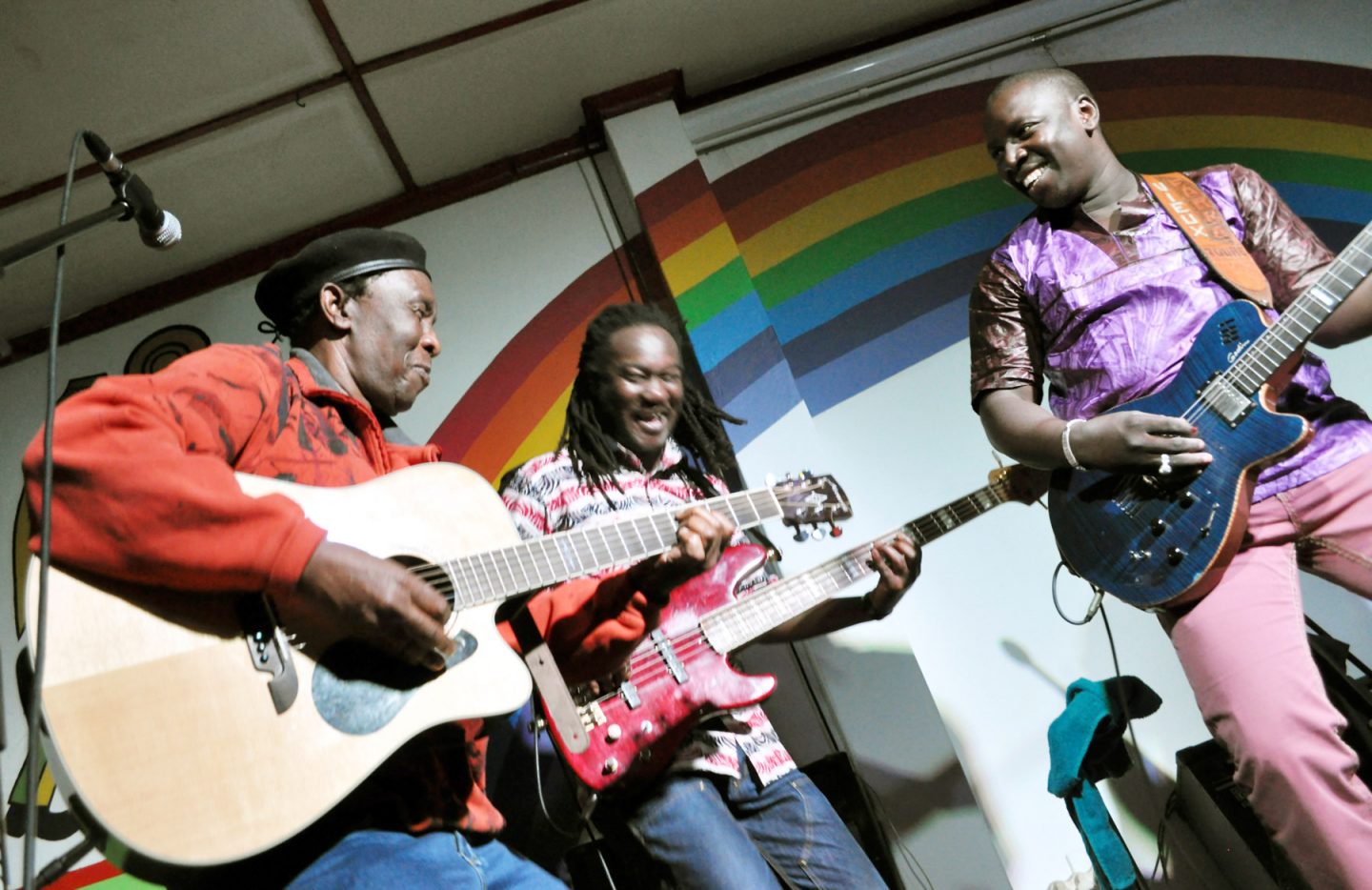
July 2014: From left, Madala Kunene with acoustic guitar and Vieux Farka Touré with electric guitar, on stage at The Rainbow.
The Rainbow has also had a long-term link with the Centre for Jazz and Popular Music (CJMP) at the University of KwaZulu-Natal, from the time when Darius Brubeck established the first jazz course and curriculum there in 1983 with visiting lecturers Mike Rossi, Larry Ridley, Chris Merz, Dusty Cox and now Salim Washington, who has married and settled in Durban.
Pretorius and Members of the Original Jazz Organisation initiated the Ronnie Madonsela Scholarship, now run by the CJPM for almost 32 years, which has helped more than 120 students with their fees and other forms of financial assistance. Bra Johnny Mekoa was the first recipient of the scholarship who completed his degree. He went on to establish his own music school in Daveyton, Benoni.
Crowdfunding
In a recent Facebook update, the venue has shared how it is navigating the challenges posed by the Covid-19 lockdown’s effects on cultural spaces, including registering employees on the Temporary Employee Relief Scheme and “trying to zero budget as many overheads”. The venue can continue to pay its bills for four more months with no trade but will be in trouble after September. They are looking into a crowdfunding campaign to save The Rainbow, keeping all who rely on the venue, including musicians, photographers and sound technicians, in mind as well.
“This will not just be about The Rainbow,” the post says, “but also about … the ongoing struggle for a free and fair South Africa.”
